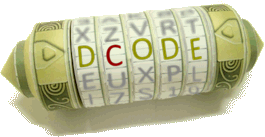Tool to find the equations of the asymptotes (horizontal, vertical, oblique or curved) of a function or mathematical expression.
Asymptote of a Function - dCode
Tag(s) : Functions
dCode is free and its tools are a valuable help in games, maths, geocaching, puzzles and problems to solve every day!
A suggestion ? a feedback ? a bug ? an idea ? Write to dCode!
Asymptote of a Function
Asymptotes Calculator
Asymptotes Checker
Answers to Questions (FAQ)
What is an asymptote? (Definition)
An asymptote is a line (or sometimes a curve) which tends (similarly to a tangent) to the function at infinity.
How to find a horizontal asymptote?
A function $ f(x) $ has a horizontal asymptote $ y = a $ if
$$ \lim\limits_{x \rightarrow +\infty} f(x)=a $$ and/or $$ \lim\limits_{x \rightarrow -\infty} f(x)=a $$
To find a horizontal asymptote, the calculation of this limit is a sufficient condition.
Example: $ 1/x $ has for asymptote $ y=0 $ because $ \lim\limits_{x \rightarrow \infty} 1/x = 0 $
There can not be more than 2 horizontal asymptotes.
How to find a vertical asymptote?
A function $ f(x) $ has a vertical asymptote $ x = a $ if it admits an infinite limit in $ a $ ($ f $ tends to infinity).
$$ \lim\limits_{x \rightarrow \pm a} f(x)=\pm \infty $$
To find a horizontal asymptote, the calculation of this limit is a sufficient condition.
Example: $ 1/x $ has for asymptote $ x=0 $ because $ \lim\limits_{x \rightarrow 0} 1/x = \infty $
Generally, the function is not defined in $ a $, it is necessary to analyze the domain of the function to find potential asymptotes.
There may be an infinite number of vertical asymptotes.
For a rational function (with a fraction: numerator over denominator), values for which the denominator is zero are asymptotes.
How to find a slant/oblique asymptote?
A function $ f(x) $ has a slant asymptote $ g(x)=ax+b $ when
$$ \lim\limits_{x \rightarrow \pm \infty} \left( f(x)-g(x)= 0 \right) $$
Computation of slant asymptote may be simplified by calculating this limit:
$$ \lim\limits_{x \rightarrow \pm \infty} \left( \frac{f(x)}{g(x)} = 1 \right) $$
For a rational function applying a polynomial division allows to find an oblique asymptote.
How to find a non-linear asymptote?
A function $ f(x) $ has a non-linear asymptote $ g(x) $ when
$$ \lim\limits_{x \rightarrow \pm \infty} \left( f(x)-g(x)= 0 \right) $$
The method is the same as the oblique asymptote calculation.
Source code
dCode retains ownership of the "Asymptote of a Function" source code. Any algorithm for the "Asymptote of a Function" algorithm, applet or snippet or script (converter, solver, encryption / decryption, encoding / decoding, ciphering / deciphering, breaker, translator), or any "Asymptote of a Function" functions (calculate, convert, solve, decrypt / encrypt, decipher / cipher, decode / encode, translate) written in any informatic language (Python, Java, PHP, C#, Javascript, Matlab, etc.) or any database download or API access for "Asymptote of a Function" or any other element are not public (except explicit open source licence). Same with the download for offline use on PC, mobile, tablet, iPhone or Android app.
Reminder: dCode is an educational and teaching resource, accessible online for free and for everyone.
Cite dCode
The content of the page "Asymptote of a Function" and its results may be freely copied and reused, including for commercial purposes, provided that dCode.fr is cited as the source (Creative Commons CC-BY free distribution license).
Exporting the results is free and can be done simply by clicking on the export icons ⤓ (.csv or .txt format) or ⧉ (copy and paste).
To cite dCode.fr on another website, use the link:
In a scientific article or book, the recommended bibliographic citation is: Asymptote of a Function on dCode.fr [online website], retrieved on 2025-11-07,
